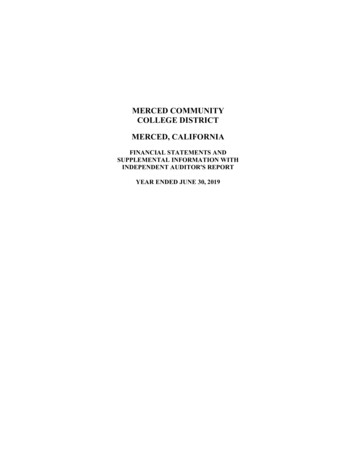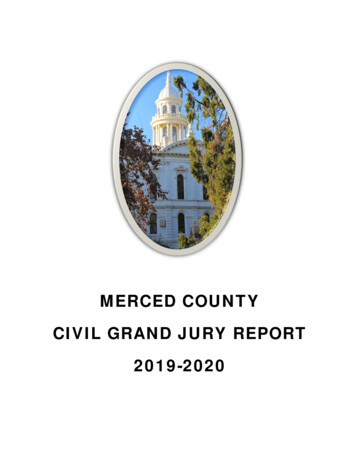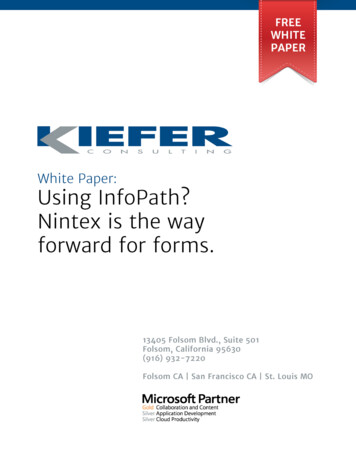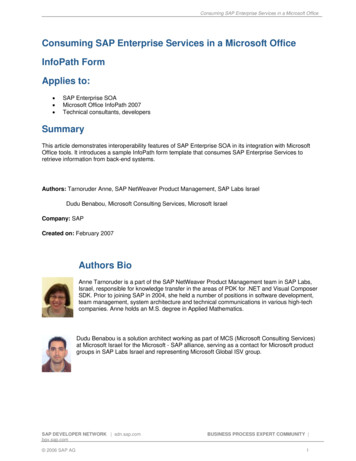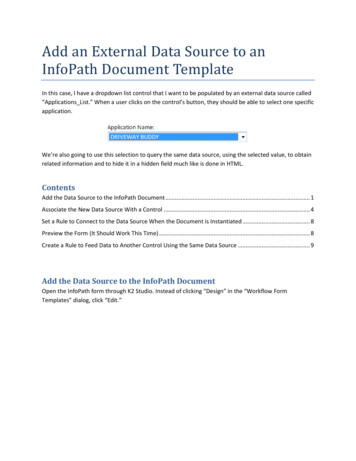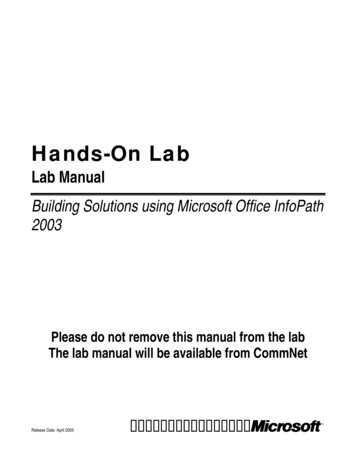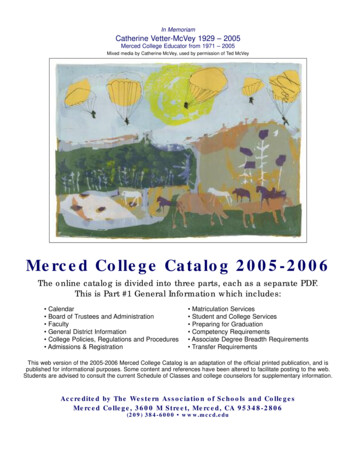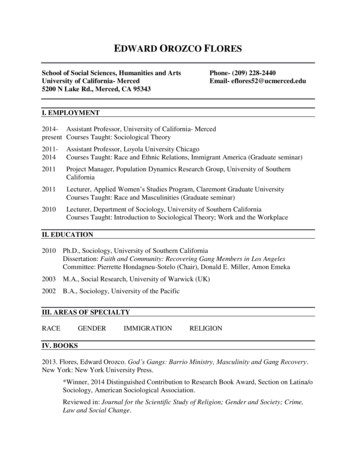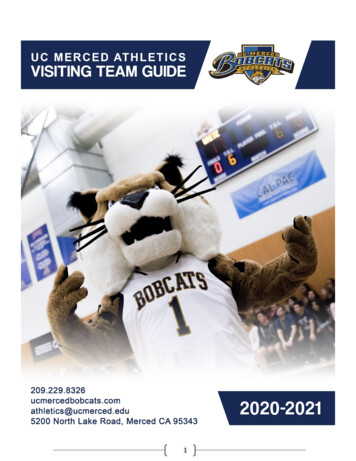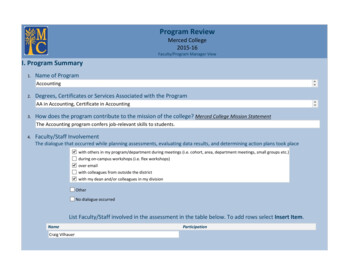
Transcription
Program ReviewMerced College2015 16Faculty/Program Manager ViewI. Program Summary1.Name of ProgramAccounting2.Degrees, Certificates or Services Associated with the ProgramAA in Accounting, Certificate in Accounting3.How does the program contribute to the mission of the college? Merced College Mission StatementThe Accounting program confers job relevant skills to students.4.Faculty/Staff InvolvementThe dialogue that occurred while planning assessments, evaluating data results, and determining action plans took place with others in my program/department during meetings (i.e. cohort, area, department meetings, small groups etc.)during on campus workshops (i.e. flex workshops)over emailwith colleagues from outside the districtwith my dean and/or colleagues in my divisionOtherNo dialogue occurredList Faculty/Staff involved in the assessment in the table below. To add rows select Insert Item.NameCraig VilhauerParticipation
Program Review AuthorDiscussion ParticipantData Contributor Ian Stapleton Program Review AuthorDiscussion ParticipantData ContributorII. Assessment Summary4.Please provide a status update of all course SLO assessments.List the dates of the last two assessment reports, starting with the most recent. (Dates must be within the last five years.)Course NumberPrevious AssessmentNext Planned AssessmentContact FacultyACTG 04AFall 2012Fall 2014Craig VilhauerACTG 04BFall 2012Fall 2014Craig VilhauerACTG 51Spring 2009Spring 2015Ian StapletonACTG 31Fall 2013Fall 2015Craig VilhauerACTG 52NoneFall 2014Ian StapletonACTG 53Spring 2013Spring 2015Craig Vilhauer5.Means of AssessmentList the program SLO/SAO in the space below.Program SLO or SAOA. Apply the fundamentals of accounting procedures, including the preparation of financial reports.Links to Institutional Learning Outcomes
CommunicationComputationCognitionGlobal and Community Consciousness and ResponsibilityPersonal Development and Life Long Learning Select means of assessment, or select Other and type in the means of assessment. Assessment results of course SLOs linked to each program SLOItem analysis of exams, quizzes, problem sets, etc. (items linked to specific outcomes)Assignments based on rubrics (essays/reports, projects, performances, presentations, etc.)Assignments based on checklistsClassroom Assessment Techniques (CATS, “clicker” mediated responses, etc.)Direct observation of performances, structured practice or drills, “practical” exams, small group work, etc.Capstone projects or final summative assessment (final exams, capstone projects, portfolios, etc.)Direct assessment of service activitiesOtherBenchmark Met Program SLO or SAOB. Analyze an accounting problem and/or scenario and apply appropriate mathematical and accounting concepts todevelop and verify a solution.Links to Institutional Learning Outcomes CommunicationComputationCognitionGlobal and Community Consciousness and ResponsibilityPersonal Development and Life Long LearningSelect means of assessment, or select Other and type in the means of assessment.
Assessment results of course SLOs linked to each program SLOItem analysis of exams, quizzes, problem sets, etc. (items linked to specific outcomes)Assignments based on rubrics (essays/reports, projects, performances, presentations, etc.)Assignments based on checklistsClassroom Assessment Techniques (CATS, “clicker” mediated responses, etc.)Direct observation of performances, structured practice or drills, “practical” exams, small group work, etc.Capstone projects or final summative assessment (final exams, capstone projects, portfolios, etc.)Direct assessment of service activitiesOtherBenchmark Met Program SLO or SAOC. Use critical thinking skills to solve an accounting problem or scenario and recommend a course of action.Links to Institutional Learning Outcomes CommunicationComputationCognitionGlobal and Community Consciousness and ResponsibilityPersonal Development and Life Long Learning Select means of assessment, or select Other and type in the means of assessment. Assessment results of course SLOs linked to each program SLOItem analysis of exams, quizzes, problem sets, etc. (items linked to specific outcomes)Assignments based on rubrics (essays/reports, projects, performances, presentations, etc.)Assignments based on checklistsClassroom Assessment Techniques (CATS, “clicker” mediated responses, etc.)Direct observation of performances, structured practice or drills, “practical” exams, small group work, etc.Capstone projects or final summative assessment (final exams, capstone projects, portfolios, etc.)Direct assessment of service activitiesOther
Benchmark Met6.Assessment Data and Results for each PLO/SAOThe Accounting Department decided to use three projects assigned in the core courses (ACTG 04A and ACTG 04B) of the programto assess program SLO attainment. Two of the projects are capstone projects that assess accumulated knowledge in ACTG 04A Financial Accounting. The other project assesses students' ability to apply material covered in the program to real lifescenarios. The latter project is administered in ACTG 04B – Managerial Accounting. The rubrics for each project are attached inthe “Attachments” section.PLO A: This program learning outcome was assessed in Fall of 2014. The project was assigned to all students in ACTG 04A. Theproject was graded using a rubric attached in the “Attachments” section. Results: 85.2% of the students achieved a score of 70%or better on the project. The average grade on the project was 84%.PLO B: This program learning outcome was assessed in Fall of 2014. The project was assigned to all students in ACTG 04B. Theproject was graded using a rubric attached in the “Attachments” section. Results: 92.4% of the students achieved a score of 70%or better on the project. The average grade on the project was 91.5%.PLO C: This program learning outcome was assessed in Fall of 2014. The project was assigned to all students in ACTG 04A. Theproject was graded using a rubric attached in the “Attachments” section. Results: 82.2% of the students achieved a score of 70% orbetter on the project. The average grade on the project was 79%.7.Analysis and Interpretation of Results for each PLO/SAO (include benchmarks)PLO A:Benchmark:80% of students will achieve proficiency for PLO A assessment. Proficiency is defined as a score of 70% or above on the capstoneproject.Analysis:As noted in item 6 above, the PLO objective was achieved with 85.2% of students achieving a score of 70% or better on theproject. We believe the successful outcome of this PLO is due to the emphasis we put on achieving this high level goal in ourprogram. Even though the PLO objective was met, we find this learning objective a difficult one to achieve. The project required toassess this learning outcome is quite daunting for some students. We have changed our strategies over time to help studentsachieve this learning outcome and have had success.
PLO B:Benchmark:80% of students will achieve proficiency for PLO A assessment. Proficiency is defined as a score of 70% or above on the capstoneproject.Analysis:As noted in item 6 above, the PLO objective was achieved with 92.4% of students achieving a score of 70% or better on theproject. We believe the successful outcome of this PLO is due to the emphasis we put on achieving this high level goal in ourprogram. We are quite pleased with the outcome of this assessment and will continue to emphasize our current instructionalstrategies to keep the achievement level high.PLO C:Benchmark:80% of students will achieve proficiency for PLO A assessment. Proficiency is defined as a score of 70% or above on the capstoneproject.Analysis:As noted in item 6 above, the PLO objective was achieved with 82.2% of students achieving a score of 70% or better on theproject. We believe the successful outcome of this PLO is due to the emphasis we put on achieving this high level goal in ourprogram. With that said, we tend to struggle with student involvement on this project. It is a very comprehensive project involvingteam work. We have employed various strategies to help bolster student involvement in order to achieve our benchmark. One ofthe more successful strategies was the institution of project checkpoints in order to assess student involvement before the projectwas due.8.Do your program outcomes represent learning appropriate to the standards of your discipline or profession? (Thismay not apply to all service areas.)Yes. The assessments we use are very high level goals that employers in our profession would require entry level accountingpractitioners to know: 1) recording basic accounting transactions, 2) preparing financial statements, 3) ability to analyze financialinformation, 4) recommend courses of action based on financial analysis.9.Plans for ImprovementPlans for improvement:PLO A:We find that this particular PLO is difficult to achieve due to student involvement issues. The project we use to assess this PLO iscomprehensive and time consuming. We have found in the past that marginal students have a difficult time starting and
completing the project. We have allowed more time for student completion of the project and that has helped in our achievementof the PLO. We believe that the institution of student check points would help student achievement. We also believe devotingclass time to the completion of the project would help.PLO B:We are pleased by the outcome of this PLO assessment. We intend to continue our current practices in order to maintain a highachievement level for this PLO.PLO C:Overall, we are encouraged by the achievement levels of this PLO, though we fully acknowledge that we can improve. The use ofcheckpoints to ensure that the teams of students are advancing towards completion of the project has definitely helped in theachievement of this PLO. One of the difficulties we have found for this particular PLO is use of teams. Some teams tend to dissolveor there are non performing teammates. One strategy we will try to employ to overcome this problem is to institute a team teacher meeting midway through the project in order to assess teammate involvement.Program Review Data:To view the relevant data for the following questions select the link below, log into the MC4MePortal, then choose your area.Instructional Program Review Data10. What trends, if any did you identify ina. student demographics for your program compared to the district?Age: The Accounting Program has fewer students aged 19 and under in our classes relative to the District, and more studentsaged 20 24 relative to the District. Other age groups were not significantly different. We would attribute the differences tothe fact that students would normally take accounting classes later in the academic careers (they are normally sophomorelevel classes).Gender: No significant differences noted between the gender make up of the Accounting Program and the District atlarge. More women than men.Race/Ethnicity: The only significant difference in the race/ethnicity make up of the Accounting Program and the District is inthe Asian category. Accounting is 8 percentage points above the District in this category. The other categories are relativelyclose to the District numbers.b. instructional demographics for your program compared to the district?
The Accounting Program course completion rates and course success rates appears slightly above the district averages. Thecourse fill rates have been slightly above district averages, though in 2015 2016 there was a dip below the districtaverage. We cannot determine a reason for this dip, though we will keep an eye on the statistics to determine if thisbecomes a trend going forward.11. Are there any factors influencing the student access to services/programs?The only factors we can see affecting student access to our program would be student financing (though this would affect studentaccess to all programs at Merced College). The cost of tuition and related course materials makes it difficult for students at MercedCollege to afford their education.III. Planning SummaryRemember to attach your goals sheet(s) in the Attachments section below. Please click here: An example of a template for an example of a template to use forrecording your program goals.Planning Goals for 15 16 PRAccounting.docxMicrosoft Word Document20.7 KBOr for the LRC, AV, or ITS click on the link below to add your goals:12.Have there been any internal/external changes to this program/department which have had a significant impact onthe program's goals and/or effectiveness? If so, please explain.There have been no changes in terms of legislation, facilities, budget or staff, and this in itself has been a problem. For manysemesters, both ACTG 4A and ACTG 4B have been oversubscribed, and we have had to turn away many students. We finallyresponded to this problem, in part, in fall 2016, adding a further section of ACTG 4A. This additional section filled completely,indicating that we had predicted demand correctly. The difficulty arose in finding a part time instructor willing to teach theadditional section. Despite actively recruiting for over six months, we were unable to attract a single applicant able to meet evenminimum qualifications.
Merced College has encouraged us to attract additional students by offering additional sections. We would like to be able to offeran additional section of ACTG 4B and an additional elective. Previously, we offered three electives (ACTG 52, ACTG 53, and ACTG56), and asked our students to select two. In recent years ACTG 56 was cut, and we now ask our students to choose anytwo "electives" from a choice of two!Making positive changes such as adding further sections of ACTG 4B and a third elective are dependent, however, on being able torecruit adjunct instructors. We have struggled in the past to do this. On the occasions we did manage to hire adjunct instructors,there have been problems with retention and, especially, quality (reflected in the number of student complaints). It is well knownthat Merced College offers unattractive pay to its adjunct instructors. As direct result, we simply cannot compete with othereducational institutions. Sadly, we are not optimistic that there will be a meaningful response to this problem.Resource AllocationzComplete the table for each resource request. Please rank in order of priority according to your program assessmentresults.ResourceLearning Outcomes Reason for ResourceSelect all that applyAccountingsoftware(QuickBooks) to beinstalled on desktop computers ofboth full timeprofessors.Also funds to bemade available sothat full timeprofessors canattendconferences /training to updateOutcomes/GoalsSelect all that applyPLO A Apply thefundamentals ofaccountingprocedures,including thepreparation offinancial reports. Institutional SLOsCommunicationComputationCognitionGlobal ConsciousnessPersonal Development SafetyComplianceMaintain ProgramGrow ProgramCommentsSoftware is needed on office computers to allow practice withthe software. I believe we need to offer more computerizedaccounting courses than we offer now (QuickBooks only),possibly as a third elective. I would like to investigate offeringa course involving both Spreadsheet skills and QuickBooks(and/or possibly another accounting program). The intention isthat students will have a wider variety of electives to selectfrom, as well as vital skills when they enter the workforce.
their skills.13.Were any of your resource allocation requests fulfilled in the last year? YES NO N/Az If yes, explain why the item was needed, how it affected student success and how you measured studentsuccess related to the requested resource.N/A14.How is your program leveraging other resources?No specific plans at this time.15.List any resources your students would benefit from having in the LRC. (i.e. books, journals, media, etc.)QuickBooks to be available on computers. More commonly used text books available on reserve.IV. Additional Information16.Is there anything else you would like to be considered in the annual planning document?NoAttachmentsPlease attach any relevant documents to the program review.Include items like, current outcomes mapping, rubrics, assessment data, and the previous assessment, if possible.To attach multiple files select Insert Item.
Program SLO AssessmentRubrics.docxMicrosoft Word Document20.6 KBAccounting Annual ProgramReview 2014 15.pdfAdobe Acrobat Document70.3 KBV. Document EvaluationSelf Evaluation of Program ReviewPlease perform a self evaluation of the completed annual program review using the criteria for proficiency below. Thepurpose of the self evaluation is to improve the quality of program review reports.Criteria for Proficiency in Program Outcomes AssessmentReviewers: Select the score from the columns that best reflects the content of the report being reviewed1. Means of Assessment2 Basic assessment procedure is clearly described.2. Assessment Data and Results3 Readily apparent how reported results provide information about student success on the stated outcome.
3. Analysis and Interpretation of Results3 Succinct analysis and reflection on the results is provided. Conclusions from collaboration and consenesus by approvpriatestakeholders.4. Plans for Improvement2 Actionable plans for improvement provided, and for the most part appear to be appropriate.Process EvaluationPlease provide feedback to the Office of Institutional Effectiveness regarding the assessment process:1. What changes to the review process or template would make program assessment more meaningful or useful to you?Keep the form static. No more changes to the form. We believe that having some kind of workshop that is required as a FLEX activitywhere faculty work together with IPRSLOAC to complete their Program Reviews early in the fall semester would help completion rates(and cut down on time required to complete the process).2. What difficulties (if any) did you experience in completing the program review?It seems like the format and requirements for Program Review are in constant flux. Even within the review period, the forms changedseveral times. That constant change makes it difficult for faculty to complete the process. A more staid process would help all involved inthe Program Review process.3. What resources (if any) would make the review easier to complete?Workshop mentioned 1. above.4. Do you have further comments or suggestions?N/AOnce complete, submit by choosing one of the options below:
For All other programs:Select your COHORT from the list below:Math/Engineering/Computer Science/AccountingMAKE SURE TO SAVE YOUR COMPLETED FORM BEFORE SUBMITTING FOR REVIEW:
6. Assessment Data and Results for each PLO/SAO 7. Analysis and Interpretation of Results for each PLO/SAO (include benchmarks) Benchmark Met The Accounting Department decided to use three projects assigned in the core courses (ACTG 04A and ACTG 04B) of the program
